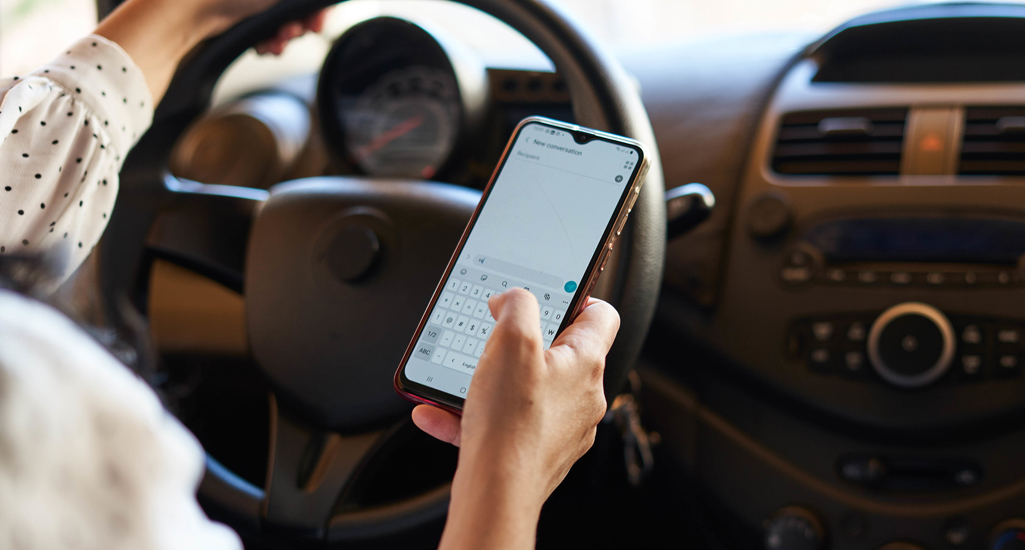Distracted driving has contributed to an alarming rise in pedestrian deaths — but new technologies that can track how frequently motorists text and scroll could lead to better enforcement and changes in driver habits, a pair of new studies argue.
According to two studies released this month from the Insurance Institute of Highway Safety, a pair of technologies — roadside cameras calibrated to capture distraction behind the wheel, as well as as apps that collect driver data known as "telematics" — can both pinpoint when and how often people handle their smartphones while they are on the road.
“The common theme across multiple studies that try to look at crash risk, is that the more complicated visual activity a driver is engaged in, the higher the crash risk goes up,” Ian Reagan, senior research scientist at IIHS, said.
“The longer you’re looking away, the more you have to do things with your hands. You have to steer the car and your hands aren’t on the wheel.”
Today, most data about cell phone distraction comes from the National Highway Traffic Safety Administration’s annual survey, conducted by human monitors who peer into vehicle cabins at intersections when a car comes to a stop and record what they see. The observers, though, only conduct their research for 12 hours a day during several weeks during the summer, rather than year-round.
Police and state troopers in some states also patrol roads for distracted drivers, and install checkpoints where they issue tickets to text-happy motorists. In New York State, which prohibits hand-held phone use and texting while driving, officials conducted a blitz in April that led to 2,860 tickets for distracted driving, out of 65,066 tickets total, according to the state DMV.
Those efforts still leave policymakers with an incomplete picture of driver behavior. So Reagan and his team sought to fill in the gaps by analyzing data from Cambridge Mobile Telematics, a Massachusetts-based software company who created an app that uses algorithms, GPS and Bluetooth connectivity to record when drivers are talking on phones or swiping at screens while their car is in motion. That data typically goes to insurance companies that offer discounted rates based on a driver’s mileage and safety habits, but the company sometimes also shares anonymized and aggregated versions of the information with groups like the IIHS.
Insurance Institute of Highway Safety researchers studied trips from passengers who downloaded the CMT app during the weeks of July and August between 2019 and 2022, to compare with the human federal traffic survey results. They found that even though phone calls became less frequent over that period, drivers still browsed their phone on one-third of their trips on average, and made a call on 3.5 percent of their trips. They also determined that drivers used their phones for just over three percent of their total travel time.
In a separate study, Reagan and his team mounted automated cameras on a roadside trailer to snap photos of distracted drivers, and compared the data to the observations of individuals who recorded their findings at intersections. They found that both methods could distinguish when a driver was using their cell phone, and concluded that cameras could do the same job as a pedestrian observer on highways — especially on remote roadways where it's often unsafe to observe cars in person.
Many municipalities have already installed red light and speed cameras on lampposts and traffic lights to discourage speeding in school zones, but aren't yet using those devices to capture evidence of cell phone usage, even though studies like this verify that they have the capability. Reagan says politics are to blame.
“There is a very vocal opposition to traffic safety cameras, whether it’s for speeding or red light running,” he said. “The political opposition raising ‘Big Brother’ concerns about privacy is going to be the same sort of thing. But if you look at residents who live in communities that have traffic safety cameras, there’s overwhelming support. Pedestrians like safety cameras.”
Some of that opposition comes from residents in predominantly Black and Latino neighborhoods who believe that speed cameras disproportionately affect drivers of color. An analysis of New York City speed camera locations found no correlation between placement and the race of residents in the surrounding neighborhoods, but unsafe arterial streets where drivers often speed are typically concentrated in communities of color. Still, some studies have shown that relying on cameras instead of cops making traffic stops may reduce racial disparities in vehicle violations.
Reagan believes that officials can avoid bias toward certain neighborhoods by putting cameras in areas where traffic injuries and fatalities are more prevalent.
“You’re not trying to catch people or bring in revenue for ticket money; you’re trying to reduce crashes. You only want to put cameras in places where crashes are occurring,” he said. “You have to get that message across.”
As for telematics, the technology is still relatively new and hasn’t been used by enough drivers for it to be an effective tool to reduce distracted driving. Other technologies such as driver monitoring systems — which look at where the driver’s head and eyes are positioned — could have even more impact on street safety if more widely adopted.
In the meantime the best solution is for drivers to put their phones away.
“The cognitive distraction effects are demonstrated in studies that when people are distracted, they stop scanning the road as much, and they tend to have tunnel vision,” Reagan said.






